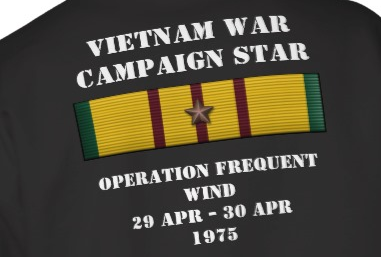
30 April 2015 is the day the city fell, and the Republic of South Vietnam was absorbed into the body of the invaders to the North. The Treaty was broken brazenly and North Vietnamese regulars supported by armor rolled toward the coast from the central highlands, cut the Republic in half, and then wheeled and headed south toward the capital.
The Americans were tired of this war, having withdrawn the combat troops in 1973. There was no stomach to come back and punish the Northerners.
That was clear enough, but there was some business that had to be done before the defeat was formal. More than a thousand Americans remained in the capital. Some Vietnamese had performed sensitive duties in the war, and it was clear that many would be tortured and killed if they were left behind. Accordingly, a last desperate evacuation was ordered, and my first ship, USS Midway (CV-41) was a critical component of the effort.
I got reports from some shipmates who were there on the decks. Mongo was scheduled to be on a helicopter to recover the remains of Charles McMahon and Darwin Judge. Others observed from other ships. Everyone knew it was the end of something profound, and very sad.
I did not report to the Midway-Maru until three years after Frequent Wind, though the stories were still vivid and real to the sailors who had participated. On this anniversary of an event that marked one of the nadirs of a really bad decade, I thought I would give you the Master Chief’s recollection of that day, and what happened in the aftermath of the end of the American War in Southeast Asia. In no small part, this is what convinced me to join the Navy.
This is for all who served, and for those who were there at the very end of it.
-Vic
Vietnam April 30, 1975
ISCM (AW) David Mattingly, USN (Ret)
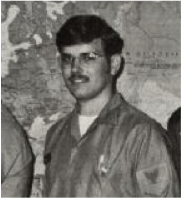
(IS3 Mattingly in 1975).
It has been forty years since the North Vietnamese Army invaded the south and the U.S. attempted to evacuate the last of the embassy diplomats, military assigned to the Defense Attaché’s office, and lastly the South Vietnamese that supported the U.S. efforts in the South East Asian country. Many of the Vietnamese served in the Republic of Vietnam’s armed forces, worked at the embassy or were intelligence sources that risked their lives to work side-by-side with the U.S.
For many American’s the U.S. role in Vietnam ended with the Paris Peace Accords in 1973. For the diplomats, DAO personnel, and Sailors and Marines of U.S. Seventh Fleet the war continued. In the early days of 1975, the North Vietnamese Army’s march south appeared unstoppable without American intervention. However, the political climate in the U.S. had changed with the resignation of President Richard M. Nixon and the ascension of Vice President Gerald Ford to the Oval Office. Ford had submitted a request for aid, but Vietnam needed more than money as the South Vietnamese army disintegrated and largely left the battlefield to go home and tend to their families.
Many of us toured and had dinner onboard my ship, USS MIDWAY, at the 2010 San Diego OS&AS Reunion. In late April, the USS MIDWAY Crew Association will celebrate the 40th Anniversary of Operation Frequent Wind. If it resembles the 35th Anniversary, hundreds of Vietnamese that made it to America via one of the Navy ships stationed off the coast will be there, flying the yellow and red flag of their former country. They will tell stories of how they left family and all they owned to start a new life in a new land. There are many stories of the evacuation; several books and movies about the last days in the city that was once known as the “Paris of the Orient.”
Many will remain untold; those that never made it out of Vietnam. Here is mine.
In the summer of 1974, I arrived as a freshly minted Photographic Intelligenceman (PT) (the predecessor of the Intelligence Specialist (IS) rating) to serve onboard the first aircraft carrier to be home ported at an overseas base, the USS MIDWAY (CV-41) or Midway Magic as she had come to be known.
The routine for Midway was to spend the colder months flying in the warmer waters of the South Pacific and use the training facilities at NAS Cubi Point, RP. The Midway Task Group left Japan as scheduled but soon after leaving Yokosuka Naval Base rumors began to circle with the news of how the war was evolving in South Vietnam.
On April 3 a large group of the embarked air wing, Carrier Air Wing 5, flew to NAS Cubi Point to make room for Marines from Okinawa that flew aboard with Marine Air Group-36’s HML-367 (11 UH-1E), HMA-369 (4 AH-1J), and HMM-164 and H&MS-36 (14 CH-46D). The Marines would later be off loaded to the USS HANCOCK (CV-19) that had recently arrived in Seventh Fleet and would participate in both the evacuation of Phnom Penh, Cambodia and Saigon, Vietnam.
While the Family Support Office at Yokosuka told the Midway wives that the ship was still on its planned mission, Japanese news outlets overflew Midway in small aircraft and reported that we were heading to South East Asia. The wives soon learned the truth when the mail arrived with “FREE” on the envelope instead of a stamp after we crossed the line into the designated combat zone.
Operation Eagle Pull, the evacuation of Phnom Penh, Cambodia, was a smaller operation and conducted by a smaller force on April 12, 1975. The Midway sat as a ready combat air wing off the coast of Vietnam in the event the helicopters needed fixed wing support. With the successful completion of the operation, the Midway returned to NB Subic Bay and started a ten day in port period that was cut short by events in South Vietnam. As the country fell to the communist army, photographs of overloaded ships with refugees and escaping soldiers appeared on the front pages of newspapers around the world. The days for the nation were few.
Midway turned east and headed for a liberty call in Subic Bay and, as was the normal routine, the air wing flew off the ship to spend the ten-day in-port period at Cubi Point. On the third morning at pier side, my Leading Chief asked if I needed to do anything ashore. I took it as an offer of a “rope-yarn day”—a day off to run errands or catch up on sleep etc.
Instead, this was an “if you have laundry ashore, go get it and get back here, we are going to sea.” Consequently, there was a mad dash to the front gate and into Olongapo City to search the hotels for shipmates on liberty; many that were in Manila or barrios throughout the countryside were left ashore to spend the operation supporting Subic Bay base operations.
The Midway also left ashore the majority of the air wing since we were ordered to steam to the Gulf of Thailand to on load, USAF 21st Special Operations Squadron (8 CH-53) and 40th Aerospace Rescue and Recovery Squadron (2 HH-53). With the exception of a ready F-4B on the catapult, the Midway was now a helicopter carrier and CVIC Mission Planning became the center for the Air Force pilots to be briefed and prepare their flight packages.
Soon after they arrived, the Air Force aircrews met in CVIC to be briefed on life aboard Midway Magic. One of the young officers had scoped out the weight room located near the foc’scle, though when he announced his finding and its location, he pronounced it as it is spelled: “fore-castle.” Smirks emerged on the faces the squadron AIs and sailors listening to the brief.
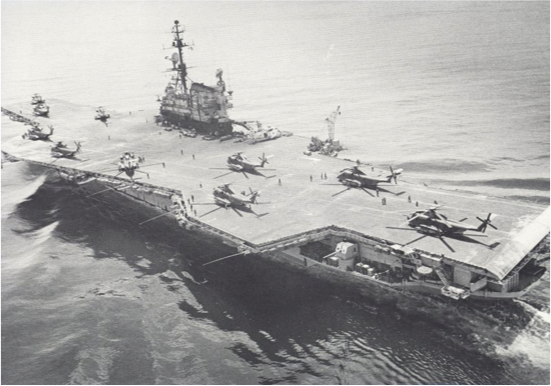
Returning to the coast of Vietnam, we maintained a position on “Dixie Station” the southern op area (The more famous northern op area, Yankee Station, was where the carriers launched strikes on North Vietnam until 1973.) As planning continued, the NVA continued moving south with cities falling without much of a fight and refugees clogging the highways and anything that could float putting out to sea.
Soon, Navy ships began taking on passengers from the overcrowded boats. And, flights from Tan Son Nhut Air Base began Operation Baby Lift: moving orphans and Amer-asian children to safety. The approaching North Vietnamese army attacked the base located on the outskirts of the capital. It rocketed the runways and DAO facility with the loss of several DIA personnel, and rendered the runways unusable. The only remaining option would be for a helicopter evacuation.
Former CIA Officer and author, Frank Snepp’s book A Decent Interval is the best source for information on what was happening in Saigon prior to the evacuation.
An issue with flying USAF helicopters from a Navy aircraft carrier is that the Air Force usually operates with plenty of room and does not equip its helicopter fleet with foldable rotors. If a CH-53 landed on a smaller-deck amphibious ship, and was unable to take off for mechanical reasons the ship would be out of action. This meant that USAF would only fly in and out of Saigon returning to the Midway, and Navy helicopters would move the refugees to the smaller-deck ships.
On the Midway, pneumatic air tubes were used to send “bunnies” containing flash and immediate precedence messages from the communications center to other parts of the ship. The tube connecting Main Comm to CVIC passed thru the squadron skipper’s stateroom. So, every night as the bunny ran thru the tube, the skipper in his robe headed to CVIC to see if the order had been given to launch and begin the operation.
After sitting off the coast near Vung Tau and watching the fireworks exploding ashore, the order was finally given to execute the evacuation of Saigon by helo. The first thing was for Marines to land and supplement the Embassy MARDET Security Guards. Then the Air Force helicopters nicknamed “Jolly Greens” started their flights, going feet wet over possible hostile territory. It was unknown at the time whether NVA would fire shoulder carried SAMS (surface to air missiles) or allow the evacuation unchallenged?
As the first helicopters approached, the cadre of ship’s company personnel were on the flight deck poised to receive the refugees. At the Embassy compound in Saigon, weapons were taken from the refugees and thrown in the swimming pool, but upon arrival on the ships, part of the process was another search. Needless to say, a large number of weapons were confiscated.
Along with the arrival of the U.S. helicopters, an armada of Vietnamese Air Force helicopters appeared: CH-47 Chinooks and UH-1 Hueys, along with a fleet of the infamous CIA Air America silver-and-blue UH-1s. Many of the South Vietnamese pilots panicked and ditched the planes in the sea near a Navy ship hoping to be picked up.
Several officers who had ground time in Vietnam tried to sort out the military and civilian refugees to identify those that had knowledge of the whereabouts of other Americans. The squadron AIs spent their time debriefing the aircrews regarding possible hostile forces, AAA guns or SAMs. The PTs tried to keep track of everything on the charts in mission planning. Today, 24/7 cable news networks and the Internet broadcast what is happening during conflicts on the ground in real time but in 1975 we monitored the wire service teletypes to get the latest AP and UPI scoop from the capital.
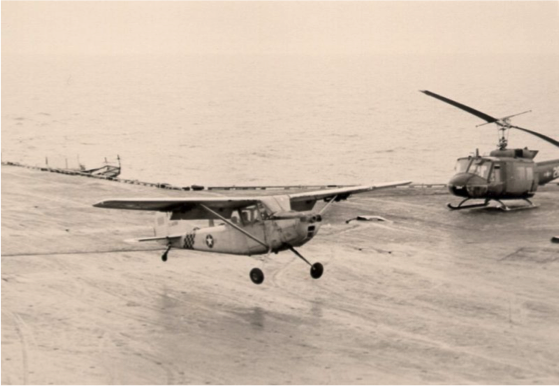
The “Miracle Plane”, an O-1 Birddog, arrived near the Midway during the afternoon of the evacuation and, at first, the intentions of the pilot were unknown. Maybe a “kamikaze” attack by an angry pilot? The other fixed wing pilots flying F-5s and A-37s flew to land bases in Thailand. The Birddog turned out to be flown by a Vietnamese major who carried as his passengers his wife and five kids. He circled Midway and one of flight deck crew members noticed he was throwing something out of the window. The miracle was that a paper page from his flight manual hit the windswept deck containing a scribbled note asking the deck to be cleared so he could land.
It took seconds for skipper CAPT L.C. Chambers to order the ramp cleared. The crew pushed a couple of Hueys and a Chinook over the side. The O-1 made the approach and came to stop in a near perfect landing.
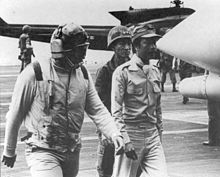
Sometime during the evacuation, Vice Air Marshall and former Vice Pres. Ngueyn Ky landed in a nearly new Huey sporting a lavender flight suit with a sporty neck scarf. The refugees continued with a mix of Vietnamese, Americans and other nationals that had been able to secure a seat.
Reporters lined the passageway outside Main Comm trying to get a “class easy” message off the ship with the news of the evacuation. The backlog started on board as the Navy birds carried fewer passengers than the larger inbound Air Force helicopters. The hanger deck became a holding area with refugees lying on the hard steel decks with only a gray navy wool blanket as a pad and the forward mess deck was opened up to feed the refugees.
As night fell, the evacuation slowed and eventually stopped with the flight deck jammed with a wild assortment of Air Force, Air America and Vietnamese helicopters, and of course, the lone O-1 Birddog. Eventually, President Ford ordered the Ambassador to leave.
With his departure the mission was over, and the last of the Marine security force flew to the fleet. (Two Marines killed during the attack at the airbase were left behind and later recovered thru diplomatic channels).
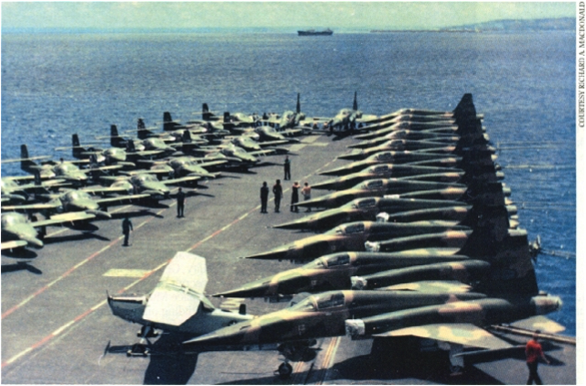
The newswires signed off and the war was over. The last of the refugees were moved to other ships and many ended up in refugee camps throughout Asia and the U.S. The task force continued to pick up refugees in small boats while the Midway headed south to drop off the Air Force helicopters and head to Subic Bay and well deserved liberty. However, when the ship arrived off the coast of Thailand, the Air Force helicopters ferried the fixed wing planes, the A-37s and F-5s, to the ship and we sailed for Guam to off-load the remnants of the Republic of Vietnam Air Force.
Sailing from Guam, Midway Magic expected to return to normal ops. However, our stop back at Subic was interrupted to support the rescue of the M/V Mayaguez, a U.S. flagged merchant ship that had been boarded by Cambodian pirates. But, that is another story for another day.
As a postscript, the Sailors and Marines that participated in Operation Frequent Wind were awarded the Armed Forces Expeditionary Medal. In 2002, Congress authorized the Vietnam Service Medal to replace the AFEM.
Information on requesting the Vietnam Service Medal is located athttp://www.usshancockcv19.com/awards/awardupdate.htm
There are many sources for information but these I have felt helpful:
USN Photos available at http://www.midwaysailor.com/midway1970/frequentwind.html
USN History of Operation Frequent Wind http://www.navalhistory.org/2010/04/29/operation-frequent-wind-april-29-30-1975
Frank Snepp, author and former C.I.A. officer in Saigon that I have stayed in touch. http://franksnepp.com/
Copyright 2014 Dave Mattingly; introduction copyright 2015 Vic Socotra
www.vicsocotra.com
Twitter: @jayare303
